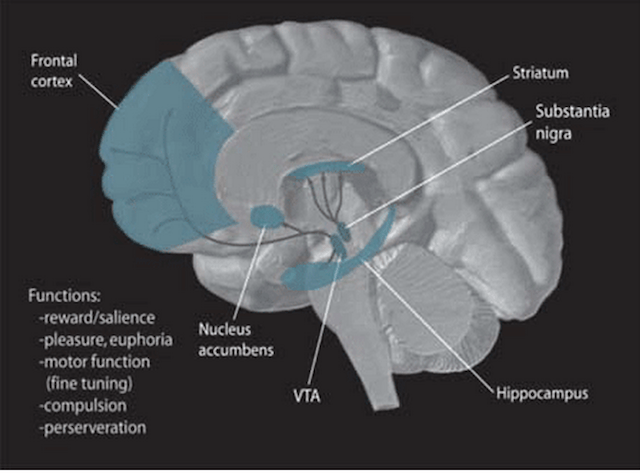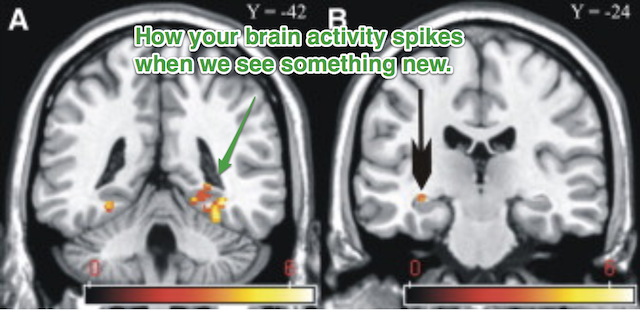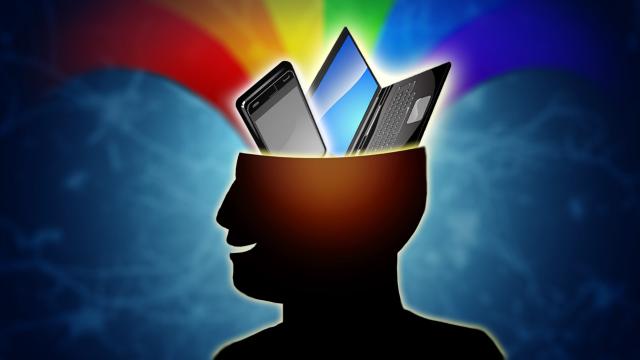We all like shiny new things, whether it’s a new gadget, new city or new job. In fact, our brains are made to be attracted to novelty — and it turns out that it could actually improve our memory and learning capacity. The team at social sharing app Buffer explains how.
Having just moved to a new country, I’m currently surrounded by novel sights, sounds and experiences. It’s an overload of new for my brain. However, after only being here a week, I’m surprised how ordinary my house and my street seem. After walking the same route to the train station three or four times, it quickly became boring. How quickly novelty can disappear as we become familiar with the things around us, and yet how completely stimulated we become when we find yet another brand new experience to have or sight to see.
It turns out, this isn’t just because I’m part of a generation of compulsive email checkers or internet addicts, or because I don’t appreciate life enough. It’s actually hardwired into my brain — and yours — to appreciate and seek out novelty.
How We Find Novelty
Anything that’s new, different or unusual is bound to catch our eye. A new phone, a new working environment, a new friend. Changing our hair colour, wearing new clothes, visiting a new place. In fact, we can even be drawn to novelty without being conscious of it. Of course, this makes a lot of sense — we wouldn’t get much done if ordinary things captivated us constantly.
The cool thing about this is how intricately novelty seems to be associated with learning, which means we can use this knowledge to our advantage for learning new things and improving our memory.
How the Brain Handles Novelty
There’s a region in our midbrain called the substantia nigra/ventral segmental area or SN/VTA. This is essentially the major “novelty centre” of the brain, which responds to novel stimuli. The SN/VTA is closely linked to areas of the brain called the hippocampus and the amygdala, both of which play large roles in learning and memory. The hippocampus compares stimuli against existing memories, while the amygdala responds to emotional stimuli and strengthens associated long-term memories.
It’s been thought before that novelty was a reward in itself, but, like dopamine, it seems to be more related to motivation. Researchers Bunzeck and Düzel tested people with an “oddball” experiment that used fMRI imaging to see how their brains reacted to novelty. They showed the subjects images such as indoor and outdoor scenes and faces with occasional novel images (oddballs) thrown in.
The experiment found that the SN/VTA was activated by novel images — that is, brand new images that hadn’t been seen before. Images that only slightly deviated from more familiar ones didn’t have the same effect, and neither did images with strongly negative emotional context, such as car crashes or angry faces. The Dopamine pathways, which are activated when we are exposed to novelty, look something like this (highlighted in blue):

A second part of the experiment was designed to test whether relative novelty or absolute novelty was required for the SN/VTA to activate. Images that were slightly more novel to the subject than others (relative novelty) were tested, as were images that were completely novel compared to others (absolute novelty).
The SN/VTA only activated when shown absolutely novel stimuli — images that had never been seen before. Other related areas of the brain still reacted to the images, but the reactions decreased slightly with each showing as they became more familiar. Dr Düzel explained it like this:
We thought that less familiar information would stand out as being significant when mixed with well-learnt, very familiar information and so activate the midbrain region just as strongly as absolutely new information. That was not the case. Only completely new things cause strong activity in the midbrain area.
This is similar to what might happen during repetition of flash cards or educational material. Only the completely new information stands out among a group of overly familiar objects or images.
How Novelty Motivates Us
You’ve probably heard about dopamine before, and its effects on the brain. It’s often touted as a “reward chemical” or part of the brain’s “reward centre”, but more recent research has shown that, like novelty, it’s actually more closely related to our motivation to seek rewards rather than being a reward itself. Animal studies around the brain’s reaction to novelty have suggested increased dopamine levels in the context of novelty. So the brain reacts to novelty by releasing dopamine which makes us want to go exploring in search of a reward.
You might remember how a new level or world to explore in a video game motivates you to play for longer, in the hopes of the reward of unlocking an achievement or gaining more points. Each new stimuli gives you a little rush of motivation to explore, because it makes you anticipate a reward. Here’s a graph that shows activity in your brain on this:

Dr Düzel said this about how novelty motivates us:
When we see something new, we see it has a potential for rewarding us in some way. This potential that lies in new things motivates us to explore our environment for rewards. The brain learns that the stimulus, once familiar, has no reward associated with it and so it loses its potential. For this reason, only completely new objects activate the midbrain area and increase our levels of dopamine.
What This Means for Learning
This is pretty interesting stuff, but it’s only useful if we can take something away from it to apply to our own lives. Unfortunately the human studies on this subject, such as the one mentioned above, are few and far between at this stage. More studies have been completed on animals, but the research is still in early stages. This doesn’t mean we can’t learn from it though. Here’s what it means for those of us who want to improve our learning and knowledge retention.
Remember how I said the hippocampus is closely tied to the SN/VTA? Well, these animal studies also showed that the plasticity of the hippocampus (the ability to create new connections between neurons) was increased by the influence of novelty — both during the process of exploring a novel environment or stimuli and for 15–30 minutes afterwards.
As well as increasing our brain’s plasticity — and therefore potential for learning new concepts and facts — novelty has been shown to improve the memory of test subjects:
Separate behavioural experiments were also conducted without the use of a scanner to test the subjects’ memory. Their memory of the novel, familiar and very familiar images they had studied was tested after 20 minutes and then a day later. Subjects performed best in these tests when new information was combined with familiar information during learning. After a 20 minute delay, subjects’ memory for slightly familiar information was boosted by 19 per cent if it had been mixed with new facts during learning sessions.
This information could help boost students’ performance both during classes and in exams, as well as helping those who suffer from memory loss. Dr Düzel pointed out the possible medical benefits that could come from this research:
We hope that these findings will have an impact on behavioural treatments for patients with poor memory. Current practice by behavioural psychologists aims to improve memory through repeatedly exposing a person to information — just as we do when we revise for an exam. This study shows that revising is more effective if you mix new facts in with the old. You actually learn better, even though your brain is also tied up with new information.
How You Can Learn More and Improve Memory
If you want to start putting these findings to work, you can improve your knowledge retention and make new ideas and concepts stick by introducing novelty into your learning process. Here are some ideas to get you started:
Add Something New
Each time you review information or facts that you’ve learned before, add in a small number of new ones. This will make your brain notice and recognise slightly familiar information more easily because it’s offset by brand new concepts.
Change Your Environment
Your environment can offer a huge amount of novel stimuli for your brain. Try offsetting the familiarity of learning material by reviewing it in new settings. On top of this, changing temperature or lighting in the room you are already in can make a big difference.
Learn After Doing Something New
Use your brain’s increased plasticity wisely by setting aside time to learn right after taking in novel stimuli. If you meet someone new for coffee or explore a new place, your brain will be more open to making new connections during and right after this time, so you might as well take advantage.
Why getting new things makes us feel so good: Novelty and the brain [Buffer]
Belle Beth Cooper has spent the past four years as a freelance writer and social media consultant. She’s written for The Next Web, Desktop Magazine and Social Media Examiner. She now spends her days wielding a pencil as Attendly’s head of content.

Comments